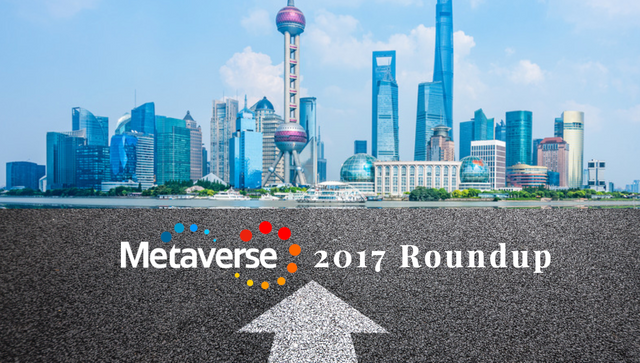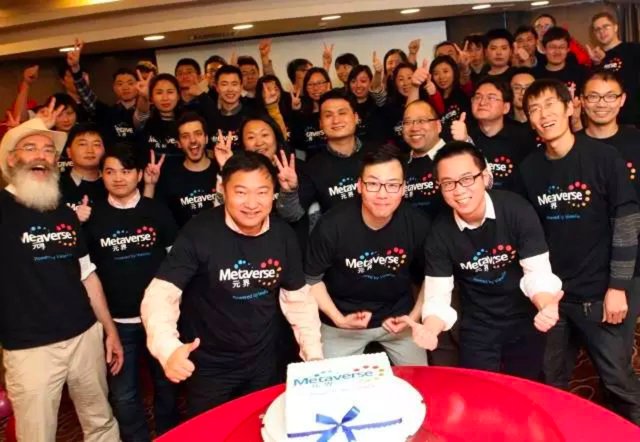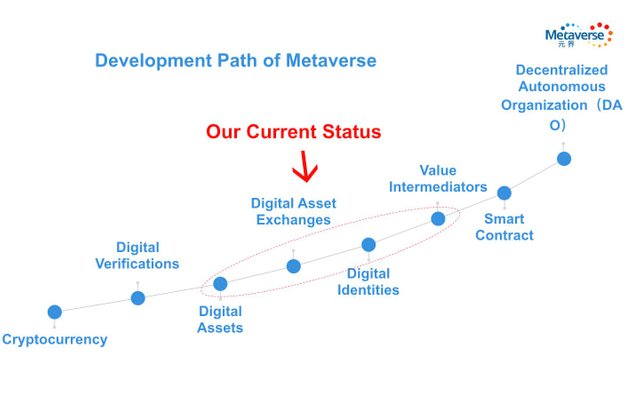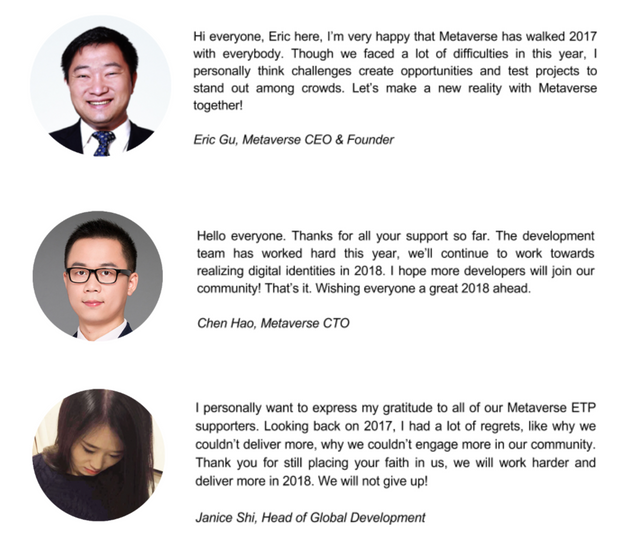Metaverse: Building A New Reality (2017 Roundup)

2017 was a year of major breakthroughs across the entire blockchain industry. Skyrocketing prices have given cryptocurrencies greater media coverage and general awareness, while corporate adoption is slowly growing, with the Enterprise Ethereum Alliance now boasting over 200 member firms.
2017 also witnessed the creation, development and growth of the Metaverse network. Since the mainnet went live in early February, the team has been working tirelessly towards the vision of building a blockchain that combines digital asset and identity functionalities, trading full decentralization for the opportunities provided by Oracles and off-chain data. To that end, progress has been made on multiple fronts including research, business development and partnerships. As the year comes to a close, we take some time to reflect on the work that has been done and outline our goals for the year ahead.
Through the looking glass
With the rapidfire, breathless updates about price, speculation and regulation, the immense progress that blockchain technology has made since the early days of Bitcoin are not always obvious. We now see applications in industries such as banking, insurance, healthcare, logistics and media. As our work and life become increasingly dependent on the Internet, Metaverse foresees a transition from the internet of information to the internet of value: an increasing number of digital assets transfers will take place online, and Avatars (Digital Identities) and intermediary Oracles will become the new mainstream economic model.
By the time Metaverse was created, established blockchain platforms such as Ethereum were hosting hundreds of decentralized applications. In response to concerns about blockchain bloat and slow transaction processing speeds, solutions such as the Lightning Network had been in development for over a year, and the number of domestic competitors was increasing by the day. Furthermore, it seemed like many consumers and blockchain projects were in favour of full privacy and decentralization, evidenced by the explosion of Zcash, Monero and other privacy-centric protocols. Given the diversity of projects already available in the marketplace, what value could Metaverse bring?
Together with the launch of Metaverse’s mainnet in February of 2017, an updated white paper was released. In it, the founding team outlined an ambitious plan for a blockchain platform that could seemingly combine the advantages of Bitcoin, Ethereum and BitShares while introducing the digital identity functions of projects like Civic.
Booting up
The Metaverse team pursued (1) a more user-friendly blockchain platform implementation, that (2) had the potential for rapid, mass adoption.
User-Friendly: This is in contrast to platforms such as Ethereum, which depended heavily on smart contracts and were mainly targeted towards developers. Ethereum’s Solidity had also previously faced criticism for being untested and difficult to write in — a large part of this can be attributed to the fact that it is very new; these difficulties are also exacerbated by problems with Solidity’s compiler and a lack of public libraries.
Mass Adoption: The disintermediation promised by many blockchains and cryptocurrencies, Bitcoin included, have yet to generate concrete gains. To truly see mass adoption with support from corporations and governments, it’s a mere fantasy that we can “cut out the middleman”. To that end, Metaverse was developed with the belief that intermediaries will continue to play an essential role in society. In the blockchain, these value intermediaries are known as “Oracles”, and provide a range of functions.
Another factor hindering the push for mass adoption was the anonymity/pseudonymity inherent or intended in blockchain protocols such as Bitcoin, Zcash and Monero. Although blockchains pride themselves on being ledgers that can keep an immutable and persistent record of transactions, this use case has few applications in the tightly regulated financial industry (which in turn grounds our entire economy) if those transactions are not linked to a credible identity.
With these factors in mind, the team marched steadily onward after the conclusion of the ICO and launched the testnet on 18 January, 2017, together with v.0.6.0 of MVSD, Metaverse’s full-node wallet. Less than a month later, the coinlock economic model was announced and the mainnet officially went live, making Metaverse the first Chinese public blockchain project.
As a team, these were exciting times. The future was ripe with promise for the blockchain industry, especially in China, where opportunities abounded.

Heroic efforts (February- August)
From Q1-Q3 (mainly from February to August), the Metaverse team was focused on iterative development of Metaverse’s full node wallet and growing our domestic market. Below we briefly outline our progress on the development, partnership, conference and community fronts since the Metaverse mainnet went live:
Development
Metaverse’s development progress can be tracked on GitHub or our blog. Some of our key milestones from February to August include:
Metaverse Mainnet Development
During this period, we followed the development path outlined in our white paper, progressing along the digital asset and digital asset exchange checkpoints. We released one major version (0.6.0) and ten minor versions (0.6.1–0.6.10) of the Metaverse client, fixing over 50 issues on GitHub. The Metaverse full-node wallet (MVSD) is supported on Mac, Windows 64-bit platforms and Linux.

Version 0.6.0 of Metaverse supported the following features:
-Asset issuance and transactions
-Account model based on Bitcoin’s HD Wallet
-User backup of master private keys
-Dual English/Mandarin user interface and mnemonic passphrase
-Partial functions of a blockchain explorer within the wallet
-All data stored locally, providing maximum security as long as users ensure the security of their device and network.
-API partially supports encrypted access for safer requests.
Successive minor version upgrades mainly addressed bugs and added new features. The following versions fixed some important bugs:
0.6.3 fixed a bug preventing miners from transferring mined ETP. After some testing, the issue was found to be due to a bug in the transaction algorithm plus no limits defined for input/output.
0.6.6 added the gettransaction command that takes the transaction hash as input and returns transaction information related to the hash as well as the block number.
0.6.7 added the ability to define the number of decimal places when issuing a new asset. Remarks could now be added to transactions. Performance and network sync was optimized, and issues with hash collisions in the database resolved. The front page of MVSD now displayed asset transaction history.
0.6.10 added multisig transactions and upgraded the local database, reducing sync times. We improved query performance and network traffic, and fixed filepath issues causing MVSD to shut automatically on Windows. A -datadir flag was added to manually configure the data directory. Issues with failure to send transactions and password/username combinations not working after a version upgrade were fixed, as were compatibility issues with various Linux distributions.
Partnership
Metaverse welcomed many strategic partnerships in May, June and July.
May: While in New York, we signed a partnership with Denmark-based OpenLedger, the world’s first blockchain powered conglomerate based on BitShares. The agreement saw ETP listed on the OpenLedger DEX, and helped raise the profile of both companies in the Chinese and European markets.
June: the Metaverse Foundation invested in European blockchain company Agrello, founded by a team of Estonian lawyers, academics and information technology experts. The teams will work together on digital agreement creation and digital identity development, allowing users to receive the assurance provided by legal agreements while transacting in revolutionary new ways.
July: the Metaverse Foundation announced an investment in Canada-based blockchain company Nuco. Nuco is a leading enterprise-grade blockchain platform built with modular components powering smart contracts and decentralized applications. It has technology and client resources for the development of consortium blockchains, and can be tailored to the specific needs of industries and use cases.
Conference & Communication
Since the mainnet went live till August, Metaverse attended several major domestic and international conferences, receiving numerous awards in the process. In April, Metaverse attended the 2nd China Fintech Conference and received the “Best Blockchain” award. In the same month, Eric and other representatives from Metaverse attended the Global Blockchain Summit in Hangzhou jointly organized by the Hangzhou Municipal Government, Zhejiang University, Zhejiang Finance Department and The People’s Bank of China, and received the “New Application” and “Innovative Technology” awards. In July, Metaverse CTO Chen Hao led a team to attend ArchSummit 2017 and gave a presentation on “Public Blockchains and Blockchain-as-a-Service”, earning the Star Speaker award.
During this period Metaverse also worked extensively with various government departments and banks. In March, Vice-Secretary of the Guiyang Municipal Government Liu Xiaolong, Deputy Director of the Guiyang National High-Tech Industrial Development Zone Gao Chuanfu and other leaders paid a visit to the Metaverse office to observe the project’s development. During the visit, representatives from Guiyang expressed their recognition and support for blockchain technology and outlined the measures taken to drive blockchain industry development in Guiyang. We also had the opportunity to discuss opportunities for future collaboration.
In May, Metaverse welcomed Global Head of Digital and Acceleration at BNP Paribas Securities Services, Jean Devambez, together with Head of Products, Investment and Fund Services Remi Toucheboeuf to the Metaverse office, where CEO Eric Gu introduced the Metaverse project and blockchain technology. Again, both parties look forward to greater collaboration in the future.
Community
Metaverse’s Chinese community was established following our ICO in 2016, with the main communication channels being WeChat and the Bitcointalk forum. WeChat groups were split into general and developer chats; an ICO thread was also opened on Bitcointalk.
After the mainnet went live in February, Metaverse created an official account on 8BTC to provide the Chinese community with a platform with consolidated information that supported discussion. Soon after, community moderators were chosen through a public vote. In the interim, our WeChat and QQ groups were growing rapidly and spilled over into multiple groups (due to maximum group sizes). Clearly, Metaverse’s growth was intricately linked to the development of its community.
Swimming upstream (September-December)
Just as Metaverse was beginning to see steady growth domestically, the Chinese government released a set of regulations for ICOs and exchanges. The projects in development on the Metaverse blockchain and ETP’s price took major hits. However, because the Metaverse project was (and is) primarily focused on blockchain development, CEO Eric Gu expressed that he would comply fully with government regulations and proceed with refunds to investors. In the face of this challenge the team held on to their initial aspirations, and moved on. We began to turn our attention to Western markets and began globalization efforts in earnest.
Development
Between September to December, we released one major version (0.7.0) and two minor versions (0.7.1–0.7.2) of the Metaverse client. A newly developed light wallet also went live during this period; two major versions (Alpha and Beta) were released as well as three minor versions (Beta 0.1.1–0.1.3).
Metaverse Mainnet Development
Version 0.7.0 was released in September, and included a complete UI redesign and reconstruction of multisig commands. The following were also added:
-Extended send commands; memos can now be added when sending transactions.
-Accounts can now be backed up by exporting an encrypted key file.
-The getaccountasset command was improved and now returns asset quantity and address information.
-Improved execution of the listtxs command and added pagination
-Improved the log system, limiting the amount of disk space taken up by the log file.
-Improved the installation package, which can now run in the background. The blockchain database is now initialized during the installation process. A blockdata-inside installation package was released to reduce the initial time required for the blockchain to sync.
0.7.1 fixed some issues (users unable to freeze coins or unable to connect to the server) and allowed users to determine a mining fee.
Metaverse Light Wallet Development
Because full node wallets require configuration of local environments and for data to be synced locally, many users faced difficulty with using the wallet and with the sync times. After feedback from the community, we began development of a light wallet that wouldn’t require users to maintain a full network node.
The light wallet entered the alpha testing phase towards the end of October, following which the Light Wallet beta was publicly released in November. Presently, the beta supports transactions and ETP freezing, and is available in five languages. Users can also choose their preferred viewing mode.
Developer Documentation
Metaverse’s documentation was updated in November with more detailed explanations of the mainnet commands and API, allowing developers to develop functions more quickly and easily.
Metaverse Database Synchronization
Metaverse synced its data to MongoDB in October, so users may now synchronize your MVSD with your MongoDB or MySQL DB. You can then run complex queries and implement database clusters to handle more traffic and maximize the availability of your services.
Partnership
Because of the blanket ICO regulations in China, Metaverse began to pivot to VC partnerships. In October, Metaverse Foundation jointly established a digital asset investment fund with the DraperDragon Innovation Fund, a venture capital (VC) fund that focuses on Sino-US cross-border investments in emerging technology industries. The investment fund will target blockchain projects, promoting the development of the Metaverse blockchain ecosystem.
To help boost digital identities and Oracles on Metaverse, we formed partnerships with Aion and Maverick Chain. Aion is a multi-tier blockchain ecosystem designed to address the unsolved problems of scalability, privacy and interoperability in blockchain networks. The partnership will explore connecting and leveraging protocol-specific oracles across networks, to increase the quality and accessibility of trusted oracles. Maverick Chain provides a complete technology solutions package encompassing asset transfer, issuance, trading and ownership validation by leveraging on the qualities of blockchain and smart contract technologies, allowing digital assets to be registered on-chain rapidly.
The Metaverse Foundation made two further partnerships in December — with global IaaS platform Acute Angle Cloud, and GE-Chain. These partnerships will provide assistance with constructing digital assets and the deployment of hypernodes respectively. With more nodes, the reach of Metaverse can be broadened, increasing the stability and security of the distributed file network.
Conference & Communication
Between September and December, Metaverse also kept busy attending internationally renowned blockchain, cryptocurrency and Fintech conferences. October saw the team head to Las Vegas for Money 20/20, the world’s current largest payments and financial services event. As the only Chinese blockchain startup represented at the conference, we shared our work on digital assets, digital identity and Oracles and received valuable feedback from attendees. It also brought us a step further in the commercialization of digital identities based on Metaverse and Blockchain-as-a-Service, something that we hope will eventually lower the cost of doing business while raising efficiency. During this period, Metaverse CEO Eric Gu also attended the World Blockchain Summit in Dubai to give a speech on the commercial applications of digital identities.
Following the setup of the digital asset investment fund with DraperDragon, Eric was invited to attend the CEO Summit Welcome Reception organized by the Draper Venture Network in November. To round off the year, Eric hopped over to Russia for Cryptospace Moscow, the largest blockchain and cryptocurrency conference in Eastern Europe. There, he gave a presentation on blockchain-based digital identities as an essential component required for the development of blockchain technology as well as its applications.
Community
In September to October, we created our Reddit, Telegram and Slack (later moved to Discord) channels. The international community has been slowly but surely growing, with over 2500 users on both Reddit and Telegram and 700 within Discord. We also remained active on specialized forums such as Bitcointalk and Steemit.
Our Twitter, Facebook and Medium pages saw much quicker growth during this period. Twitter and FB currently stand at over 17,000 and 11,000 followers respectively.
In December we were really excited to hold our very first international meetup in Seoul with the official Korean Metaverse community, and have the opportunity to interact with them. We realized that many of our achievements would not have been possible without our community — for example, the upgrade of our blockchain explorer to include hash power distribution was contributed by a mining pool. Events such as our website redesign and AMA also received large amounts of community feedback, for which we are grateful.
Dreaming Forward
Throughout our setbacks and successes, we’ve never lost sight of our goal — to create a new reality. 2018 will be no different, and development towards digital identities will continue, as originally outlined in Metaverse’s white paper. Be it the research and development of our core blockchain or strengthening of the Metaverse blockchain ecosystem and community, we’ll continue reaching for greater heights in 2018.
